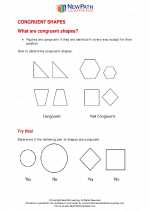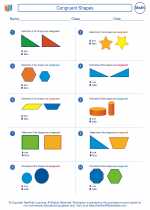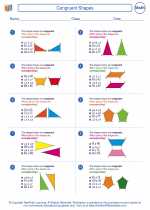Congruent Shapes -> multiplication
Multiplication
Multiplication is a fundamental operation in mathematics that involves repeated addition. It is the process of combining groups of equal numbers to find a total. The numbers being multiplied are called the multiplicand and the multiplier, and the result is called the product.
Basic Multiplication Fact
When you multiply two numbers, the order of the numbers does not matter. The product will be the same. For example, 3 x 4 is the same as 4 x 3, and both equal 12.
Multiplication Properties
- Commutative Property: The order of the numbers does not affect the result of the multiplication. For any numbers a and b, a × b = b × a.
- Associative Property: The grouping of the numbers being multiplied does not affect the result. For any numbers a, b, and c, (a × b) × c = a × (b × c).
- Identity Property: The product of any number and 1 is the number itself. For any number a, a × 1 = a.
Multiplication Techniques
There are various techniques to perform multiplication, including:
- Repeated Addition: Multiplying by a number is the same as adding that number multiple times. For example, 3 x 4 is the same as 4 + 4 + 4.
- Using Tables: Multiplication tables, also known as times tables, are a helpful tool for memorizing multiplication facts.
- Using Arrays: Arrays can be used to visually represent multiplication. The rows and columns of the array correspond to the multiplicand and the multiplier.
Study Guide
Here are some tips for studying and practicing multiplication:
- Memorize multiplication tables up to 12x12.
- Practice multiplication using flashcards or online games.
- Work on word problems involving multiplication to understand real-life applications.
- Understand the properties of multiplication and how they can be used to simplify calculations.
- Learn different multiplication techniques such as the lattice method or the traditional algorithm.
By mastering multiplication, you will build a strong foundation for more advanced mathematical concepts and problem-solving skills.
[Multiplication] Related Worksheets and Study Guides:
.◂Math Worksheets and Study Guides Fifth Grade. Congruent Shapes
Study Guide Congruent Shapes
Congruent Shapes  Worksheet/Answer key
Worksheet/Answer key Congruent Shapes
Congruent Shapes  Worksheet/Answer key
Worksheet/Answer key Congruent Shapes
Congruent Shapes  Worksheet/Answer key
Worksheet/Answer key Congruent Shapes
Congruent Shapes 

 Worksheet/Answer key
Worksheet/Answer key
 Worksheet/Answer key
Worksheet/Answer key
 Worksheet/Answer key
Worksheet/Answer key

The resources above cover the following skills:
Geometry (NCTM)
Analyze characteristics and properties of two- and three-dimensional geometric shapes and develop mathematical arguments about geometric relationships.
Identify, compare, and analyze attributes of two- and three-dimensional shapes and develop vocabulary to describe the attributes.
Explore congruence and similarity.